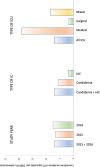Incidence and outcome of invasive candidiasis in intensive care units (ICUs) in Europe: results of the EUCANDICU project
- PMID: 31200780
- PMCID: PMC6567430
- DOI: 10.1186/s13054-019-2497-3
Incidence and outcome of invasive candidiasis in intensive care units (ICUs) in Europe: results of the EUCANDICU project
Abstract
Background: The objective of this study was to assess the cumulative incidence of invasive candidiasis (IC) in intensive care units (ICUs) in Europe.
Methods: A multinational, multicenter, retrospective study was conducted in 23 ICUs in 9 European countries, representing the first phase of the candidemia/intra-abdominal candidiasis in European ICU project (EUCANDICU).
Results: During the study period, 570 episodes of ICU-acquired IC were observed, with a cumulative incidence of 7.07 episodes per 1000 ICU admissions, with important between-center variability. Separated, non-mutually exclusive cumulative incidences of candidemia and IAC were 5.52 and 1.84 episodes per 1000 ICU admissions, respectively. Crude 30-day mortality was 42%. Age (odds ratio [OR] 1.04 per year, 95% CI 1.02-1.06, p < 0.001), severe hepatic failure (OR 3.25, 95% 1.31-8.08, p 0.011), SOFA score at the onset of IC (OR 1.11 per point, 95% CI 1.04-1.17, p 0.001), and septic shock (OR 2.12, 95% CI 1.24-3.63, p 0.006) were associated with increased 30-day mortality in a secondary, exploratory analysis.
Conclusions: The cumulative incidence of IC in 23 European ICUs was 7.07 episodes per 1000 ICU admissions. Future in-depth analyses will allow explaining part of the observed between-center variability, with the ultimate aim of helping to improve local infection control and antifungal stewardship projects and interventions.
Keywords: Abdominal candidiasis; Candida; Candidemia; Candidiasis; ICU; Incidence.
Conflict of interest statement
Outside the submitted work, MB reports grants and personal fees from Pfizer, grants and personal fees from MSD, grants and personal fees from Cidara, personal fees from Astellas, and personal fees from Gilead. DRG reports personal fees from Stepstone Pharma GmbH and an unconditioned grant from MSD Italia. GD reports personal fees from Pfizer, Infectopharm, and EU/FP7/Magic Bullet and a grant for his institution from MSD. JLGG reports a formative grant from MSD, a formative grant from Fresenius, and payment for lecture from Astra Zeneca. BJK reports grants for his institution from Amplyx, Astellas, and Cidara. KL has received research grants from Gilead, MSD, and Pfizer; consultancy fees from Gilead, Pfizer, Abbott, MSD, and SMB Laboratoires Brussels; travel support from Pfizer, Gilead, and MSD; and speaker fees from Gilead, Roche, and Abbott. JFT has received grants for his institution from Pfizer and MSD and personal fees from BioMérieux and participated in advisory board for MSD, Bayer, 3 M, and Gilead. PM reports personal fees from Pfizer and MSD. The other authors declare that they have no competing interests.
Figures
References
-
- Guery BP, Arendrup MC, Auzinger G, Azoulay E, Borges Sá M, Johnson EM, et al. Management of invasive candidiasis and candidaemia in adult non-neutropenic intensive care unit patients. Part I. epidemiology and diagnosis. Intensive Care Med. 2009;35:55–62. doi: 10.1007/s00134-008-1338-7. - DOI - PubMed


